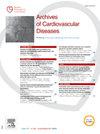Comparison of angiography-derived index of microcirculatory resistance measurements between low and high frame-rate acquisitions: The prospective ADMIRAL-study
IF 2.3
3区 医学
Q2 CARDIAC & CARDIOVASCULAR SYSTEMS
引用次数: 0
Abstract
Introduction
Angiography-derived index of microcirculatory resistance (angio-IMR) is a novel, wire-free, angiography-based method (QFR-IMR®) to assess coronary microvascular dysfunction. If a frame-rate of 15 frames per second (fps) is recommended, there is an interest in decreasing this frame-rate to reduce X-ray exposure. However, the impact of frame-rate reduction on angio-IMR quantification has not been investigated.
Objective
To compare angio-IMR at 7.5 fps (angio-IMR low) to angio-IMR at 15 fps (angio-IMR high) in a multicentric study.
Method
From October 2023 to February 2024, we conducted a multicentre prospective study including consecutive patients referred for an invasive coronary angiogram with a final diagnosis of ischemia with no obstructive coronaries arteries (INOCA) or acute coronary syndrome (ACS). In ACS patients, angio-IMR was measured after revascularisation. The same two acquisitions were recorded at a rate of 7.5 fps and a rate of 15 fps to measure angio-IMR in the selected vessel (culprit coronary vessel in ACS patients or left anterior descending artery in patients with INOCA). Angio-IMR was measured with dedicated software (QFR-IMR® RE, Medis Medical Imaging). Correlation between angio-IMR low and angio-IMR high was then assessed, as well as the diagnostic accuracy of angio-IMR low to predict microcirculatory dysfunction (defined as angio-IMR high≥ 25 for INOCA and ≥ 40 for ACS). Statistical significance was awarded by P≤0.05.
Results
Among 75 patients, 57 ACS and 18 INOCA were included (mean age 61 ± 12 years, 72% male). Angio-IMR low (median = 35; [IQR: 28–48]) was slightly but significantly higher (P = 0.04) than angio-IMR high (median = 34; [IQR: 25–45]). Angio-IMR low and angio-IMR high were significantly correlated (r = 0.90; P < 0.0001) as showed in Fig. 1. Using angio-IMR high to diagnose microcirculatory dysfunction as reference, angio-IMR low achieved positive and negative predictive values of 83% and 85% respectively with 63 concordant patients, 6 false positives, and 6 false negatives.
Conclusion
Correlation between angio-IMR high and angio-IMR low is good even if angio-IMR low measurement is slightly higher than angio-IMR high. Lowering frame acquisition rate reduces radiation exposure without relevantly impact on the diagnostic accuracy of angio-IMR.
求助全文
约1分钟内获得全文
求助全文
来源期刊

Archives of Cardiovascular Diseases
医学-心血管系统
CiteScore
4.40
自引率
6.70%
发文量
87
审稿时长
34 days
期刊介绍:
The Journal publishes original peer-reviewed clinical and research articles, epidemiological studies, new methodological clinical approaches, review articles and editorials. Topics covered include coronary artery and valve diseases, interventional and pediatric cardiology, cardiovascular surgery, cardiomyopathy and heart failure, arrhythmias and stimulation, cardiovascular imaging, vascular medicine and hypertension, epidemiology and risk factors, and large multicenter studies. Archives of Cardiovascular Diseases also publishes abstracts of papers presented at the annual sessions of the Journées Européennes de la Société Française de Cardiologie and the guidelines edited by the French Society of Cardiology.
 求助内容:
求助内容: 应助结果提醒方式:
应助结果提醒方式:


